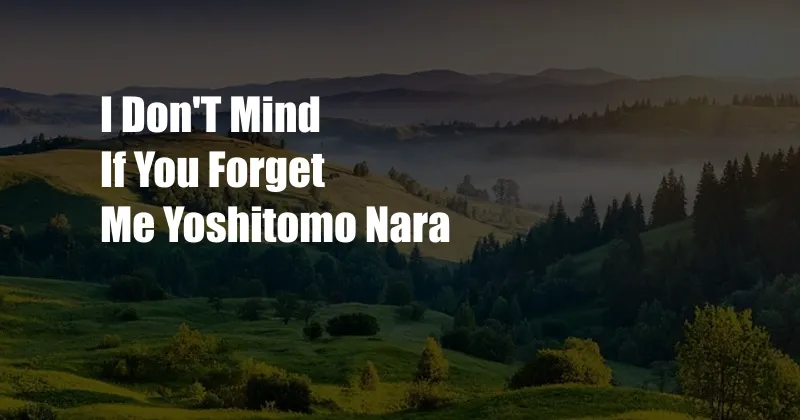
I Don’t Mind if You Forget Me: The Art of Yoshitomo Nara
As I strolled through the vibrant streets of Tokyo, my gaze was drawn to an image that left an imprint on my soul. It was a painting by renowned contemporary artist Yoshitomo Nara, featuring a young girl with piercing eyes and a pensive expression. The simplicity of the lines and the raw emotion conveyed in her gaze stirred something deep within me. In that moment, I realized the power of art to transcend time and language, connecting us with the human experience.
Nara’s artwork, predominantly characterized by depictions of children, exudes a profound sense of innocence, vulnerability, and longing. Through his unique style, he explores the complex emotions and inner struggles of childhood, inviting us to confront the bittersweet memories and experiences that shape our lives.
The Language of Innocence
In Nara’s paintings, children are not merely subjects but symbols of universal human emotions. Their wide-eyed gazes seem to penetrate the viewer’s soul, reflecting our own vulnerability and the innocence we often lose as we navigate the complexities of adulthood. Nara’s children are not idyllic or idealized; they are real, with all their flaws and imperfections.
Through their seemingly simple expressions, Nara’s figures convey a myriad of emotions, from joy and curiosity to sadness and loneliness. By capturing these fleeting moments, he invites us to reflect on the fragility of childhood and the importance of preserving its innocence.
The Art of Memory and Loss
Nara’s work is not merely a celebration of childhood but also an exploration of memory, loss, and the passage of time. The enigmatic titles of his paintings, such as “I Don’t Mind if You Forget Me” and “Sleeping Alone,” hint at the fleeting nature of human existence.
In his paintings, children are often depicted alone, surrounded by empty space. This isolation symbolizes the loneliness and vulnerability that can accompany the transition from childhood to adulthood. Nara’s art reminds us that while memories may fade and loved ones may disappear, the emotions they evoke remain etched in our hearts.
Contemporary Art and Cultural Identity
Yoshitomo Nara is a significant figure in contemporary art, not only for his unique artistic style but also for his contributions to Japanese cultural identity. His work has been exhibited worldwide, earning him international acclaim and recognition as a leading voice in contemporary art.
Nara’s paintings resonate with a global audience, transcending cultural boundaries and speaking to the universal human experiences of childhood, memory, and loss. His art has become a symbol of Japanese contemporary art, showcasing the country’s rich cultural heritage and artistic innovation.
Experiencing Nara’s Art: Tips and Advice
To fully appreciate the depth and emotion conveyed in Yoshitomo Nara’s artwork, it is essential to experience it in person. Here are some tips and expert advice to enhance your experience:
- Visit a Museum Exhibition: Nara’s artwork is often showcased in major museums worldwide. Take advantage of these opportunities to immerse yourself in his collection and engage with the original pieces.
- Read about the Artist: Familiarize yourself with Nara’s life, artistic journey, and inspirations. This will provide a deeper understanding of the context and meaning behind his paintings.
- Participate in Guided Tours: Many museums and galleries offer guided tours led by experienced art historians. These tours provide insights into Nara’s techniques, symbolism, and the broader context of contemporary art.
Frequently Asked Questions
**Q: What is the significance of children in Yoshitomo Nara’s paintings?**
A: Nara’s children symbolize universal human emotions, vulnerability, and the innocence often lost in adulthood. They represent the fragility and beauty of childhood.
**Q: How does Nara explore themes of memory and loss in his work?**
A: Through enigmatic titles and depictions of isolated children in empty spaces, Nara’s paintings evoke the fleeting nature of memories and the loneliness that can accompany the passage of time.
**Q: What makes Yoshitomo Nara a significant figure in contemporary art?**
A: Nara’s unique artistic style, exploration of universal human experiences, and contributions to Japanese cultural identity have earned him international acclaim as a leading voice in contemporary art.
Conclusion
Yoshitomo Nara’s art invites us to contemplate the complexities of childhood, memory, and loss. Through his insightful portrayals of children, he captures the essence of the human experience, reminding us of the innocence we have left behind and the bittersweet memories we carry forward.
Are you intrigued by the world of Yoshitomo Nara’s art? Explore his captivating paintings and discover the profound emotions they evoke. Engage with the topic, share your thoughts, and let his art resonate with you.